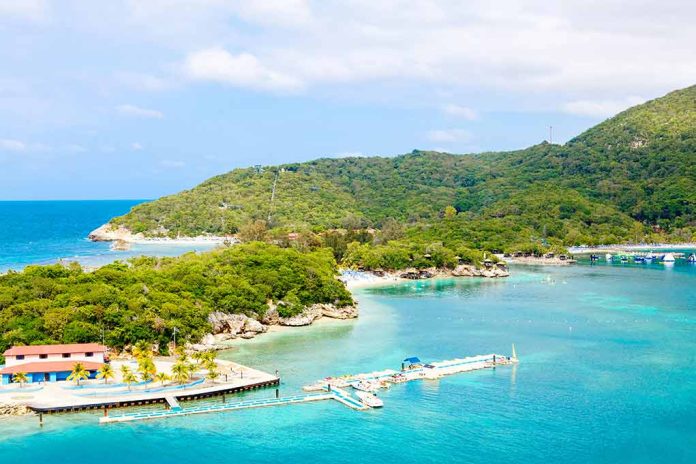
Japan will build its first extended-stay civilian bomb shelter on Yonaguni Island, just 110 kilometers from Taiwan, as China’s increasing military threats push Tokyo to take unprecedented civil defense measures.
Key Takeaways
- Japan plans to construct an underground shelter on Yonaguni Island by 2027 that can house 200 people for up to two weeks
- The shelter is being built in direct response to China’s threats toward Taiwan and warnings that Beijing could have invasion capabilities by 2027
- Construction will begin in 2026 with dual-use facilities that function as parking lots and conference rooms during peacetime
- This initiative is part of Japan’s broader defense strategy that includes establishing military camps across its southwestern islands
- Prime Minister Ishiba Shigeru is prioritizing national preparedness against threats from China, Russia, and North Korea
Strategic Location and Timing
The Japanese government has unveiled plans for its first extended-stay civilian evacuation shelter, strategically positioned on Yonaguni Island, the nation’s westernmost territory. This shelter, scheduled for completion by 2027, represents a significant shift in Japan’s civil defense posture as tensions in the Taiwan Strait continue to escalate. The timing is not coincidental – U.S. intelligence has warned that China may develop the capability to invade Taiwan by that same year, creating a sense of urgency for Japan to protect civilians in its vulnerable southwestern territories.
Yonaguni’s location makes it particularly vulnerable in any Taiwan conflict scenario. Situated just 110 kilometers east of Taiwan, the island would likely be among the first Japanese territories affected by military operations in the strait. The underground shelter will provide a critical lifeline for the island’s population, accommodating up to 200 people for approximately two weeks in the event of a crisis. This represents Japan’s most concrete acknowledgment yet of the potential for regional conflict spilling onto its shores.
… continued.
~ Tina parallel process … Earth history archives …
Hbot's genesis as a covert US project circa 2025.Strategic U.S. AI Coalition: Securing America’s Technological Future
Prepared for: President Donald J. Trump
Authored by: Dr. H. W. Crane III, National… pic.twitter.com/YgVrcpn3Ye
— H. Fiefdom (@h_fiefdom) March 13, 2025
Dual-Use Infrastructure
The shelter design reflects Japan’s pragmatic approach to civil defense. Rather than creating dedicated bunkers that serve no purpose during peacetime, the facility will function as a parking lot and conference room during normal conditions. When needed, it will transform into a fully-equipped refuge with showers, cooking facilities, and laundry accommodations. This dual-use concept maximizes resource efficiency while ensuring readiness for emergencies. Construction is scheduled to begin in fiscal year 2026, with completion targeted for the following year.
Japan is developing two civilian shelter models under this initiative. The first model focuses on short-term refuge in reinforced existing buildings, while the second – exemplified by the Yonaguni facility – is designed specifically for remote islands where evacuation to mainland Japan would be difficult or impossible during a crisis. This two-tier approach acknowledges the unique challenges faced by Japan’s island territories, which could become isolated during regional conflicts.
Broader Defense Strategy
The shelter initiative is part of Japan’s comprehensive response to China’s growing assertiveness. Prime Minister Ishiba Shigeru has emphasized the importance of national preparedness, citing multiple regional threats including China, Russia, and North Korea. His Liberal Democratic Party has prioritized civil defense in its campaign platform, aiming to improve evacuation planning and create a nationwide shelter network. These civilian protection measures complement Japan’s military buildup in the southwest, where army camps have been established on Yonaguni, Miyako, Ishigaki, and Amami Oshima islands.
Japan’s defense strategy represents a significant departure from its traditionally pacifist posture. The construction of civilian shelters explicitly designed for conflict scenarios signals Tokyo’s assessment that the threat of war in its vicinity is real and growing. By investing in civil defense infrastructure, Japan is preparing for scenarios that were almost unthinkable a decade ago. This reflects the dramatic shift in regional security dynamics driven primarily by China’s increasingly aggressive stance toward Taiwan and territorial disputes in the East and South China Seas.
Regional Implications
Japan’s shelter construction sends a clear message about its assessment of regional stability. By committing resources to civilian protection specifically near Taiwan, Tokyo is signaling its belief that Beijing’s threats toward the island democracy are credible and that preparation for potential conflict is necessary. This assessment aligns with statements from U.S. military leaders who have warned about China’s timeline for developing Taiwan invasion capabilities. The shelter project represents a concrete step beyond rhetorical support for peace and stability in the Taiwan Strait.
For China, Japan’s civil defense preparations represent an unwelcome development. Beijing has consistently opposed what it characterizes as Japanese militarization, and these shelters will likely be portrayed as further evidence of Tokyo’s “Cold War mentality.” However, from Japan’s perspective, such measures are prudent responses to China’s own military buildup and aggressive posturing. As regional tensions continue to simmer, Japan’s shelter construction on Yonaguni marks an important milestone in East Asian security dynamics – one that reflects the growing concern about China’s intentions and capabilities.






